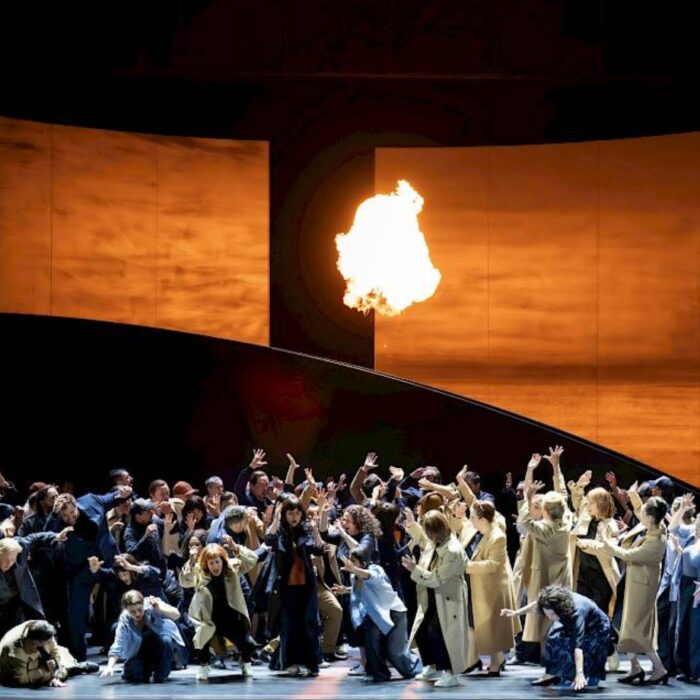
Royal Opera 2024-25 Review: ‘Trouble in Tahiti’ & ‘A Quiet Place’
Oliver Mears Makes a Valiant Attempt at Unpuzzling Bernstein’s Late Opera
By Benjamin Poore(Photo: ©2024 Marc Brenner)
It is the first time The Royal Opera have staged Leonard Bernstein’s valedictory operatic double-bill of “Trouble in Tahiti” and “A Quiet Place,” presented in the Linbury Theatre. It is conducted by Nicholas Chalmers, who is also making his Covent Garden debut, and directed by Oliver Mears.
“Trouble in Tahiti” is from 1954, and is separated from its sequel “A Quiet Place” by nearly three decades. It tells the story of the unhappy marriage of Dinah and Sam, whose suburban bliss – it could be anywhere in 50s America – is ruthlessly sent up over a day in the life. In Mears’s production Dinah’s response to all of this is drinking and delusion, and bad dreams that she relays to her psychoanalyst; her husband’s is to dive deeper into his own delusional masculine self-image. As they part and come together they are haunted by the sterility that has settled over their marriage and try, after confronting each other in the evening, to rather ambiguously make another go of it. Though treading the borderline between opera and musical, the mood is dark and the work’s satirical teeth sharp. Just as Sam calls her analyst an “out-and-out fake,” we are reminded – in true Freudian fashion – that faking it is what everybody in the show is doing in the end.
At great cost, too, “A Quiet Place” begins with Dinah’s death in a car crash. We and the now estranged family of Junior, an older Sam, younger sister Dede, and Francois (part of Dede and Junior’s unconventional Canadian living arrangement) eventually learn that it was suicide. The revelation comes after a vicious funeral in which gossip circulates about Dinah (she was a drinker; she was mad) at which Junior – gay and unwell – has it out with his broken father. As they all return to the family home, they try to make sense of each other and Dinah’s death, eventually coming together thanks to Francois’s exhortation that they must love each other as they are, for all their failings. It’s a complex exploration of grief and family, and much else besides.
“A Quiet Place”, like Junior, had a difficult childhood. It was initially conceived as presented at the Royal Opera, with “Trouble in Tahiti” acting as first-half prologue. A poor reception saw Bernstein revise the work so that “Trouble in Tahiti” was nested inside it, as a kind of flashback, as well as chopping out various extraneous characters and music from the sequel; though even in its revised form it still runs around 100 minutes. The version presented in the confines of the Linbury Theatre features a reduced orchestration, with a few further cuts, from Garth Edwin Sunderland. It’s a creditable version on its terms – the pit-band scale marries the sound to Bernstein’s big musical theater successes like “On The Town” or indeed “West Side Story,” as well as capturing the fresh, sinfonietta feel of the score’s more modernist twitches.
Bernstein’s critics weren’t wholly wrong. It’s an unwieldy piece that goes on far too long and feels wildly unfocused, and was surely in need of dire editorial intervention from his publisher. Inside the score Bernstein has buried icy, searing music of grief, anger, and recrimination, and in the text we can also hear a vicious attack on the conservatism of Reagan’s America, especially its sexual and nationalistic mores. Its politics and musical ingenuity are both washed away, though, by too much nondescript, directionless filler – much of the score is rather schlocky and sentimental without having many memorable tunes, and the text is often unfocused and rambling. Ensembles are far too prevalent and overworked, rendering the psychological observations implied illegible; a devastating revelation about an incestuous family relationship feels weirdly anti-climatic and is quickly forgotten. The opening funeral scene has far too many characters, most of whom add nothing.
Insightful Production by Oliver Mears
Tough gig for Oliver Mears, then, but as Artistic Director of the Royal Opera he does get to choose them. His staging, given all the above, is remarkably effective and brings a taut, crisp restraint that really does underline the best things in both works – especially a Lear-like realization of Sam in “A Quiet Place,” which was the outstanding feature of the evening. Designed by Annemarie Woods and lit by Fabiana Piccioli, it takes place in a simple rectangular box that emphasizes the emotional chilliness and isolation that is at the heart of family, bisected down the middle to show the marital bedroom and Junior’s childhood one, in which emptiness and alienation are the principle decorations.
The garden that the late Dinah so lovingly tended – now overgrown – is created, quite brilliantly from the furniture of the bedroom, with a strange mattress-shifting sequence, with dirt poured on top. Father, children, and Francois come together around the wreckage of the family home to try and build another, and play in its ruins. Costumes belong to the period, with Junior given a wonderfully outlandish get up for the surreal and distressing funeral striptease, which is done with white-knuckle commitment. At the conclusion, as the light falls, there is tenderness and control; both Mears and cast have clearly worked extremely hard to bring the characters into focus – it’s just a pity Bernstein’s garrulousness gets in the way, ultimately.
“Trouble in Tahiti” is similarly spare. The green walls of this less-than-happy suburban home have an institutional feel that renders the whole thing rather unheimlich. Mears leans into the unseen characters – psychoanalyst, milliner, secretary, etc. – to heighten the isolation of the central pair, as well as the delusions that attend them – Sam swaggering about his office as the chorus intone what a swell guy he is, or the empty triumphalism of “There’s A Law About Men,” as he whacks a punchbag. A shadowy impression of the shower room beyond, and what lies within, suggests his machismo might have another unrealized offshoot. As young Sam and Junior were played by the same singer, there is a striking implication that the patriarch’s viciousness towards his son’s sexuality is born of jealousy and shame about desires buried within himself, and that Junior is a kind of flourishing sexual alter ego – it’s a smart touch.
The trio of voices that sing the silly jingles that punctuate the piece are a malevolent group above the stage, or otherwise piped in, as if they are coming straight out of the wireless; “a Greek chorus born of the radio commercial,” as Bernstein had it. One of the high points of the show is the dynamic, vaudeville account of the titular movie Dinah goes to see in lieu of her son’s play, which is done as a wild, drunken delusion in her bedroom, where she is both joyful and defiant. The son, normally unseen, is given stage time by Mears, struggling to do up his father’s tie for the play, in a touching reminder of their failure to be in his life – with the consequences born out in the sequel.
The story of this unhappy family invites inevitable biographical parallels with Bernstein’s own difficult marriage to Felicia Montealegre and the less-than-conventional sexual and domestic arrangements entailed; music from both pieces featured in Bradley Cooper’s “Maestro” from last year, which told that story. But the size of the piece, along with its rather rambling character, outsized opening ensemble, and stylistic ambition – even if the score is flawed – perhaps points to something else. Bernstein’s own desire as a composer to try and play happy families with his adored vernacular musical traditions of the United States – radio jingle, Broadway, and silver screen – with the European symphonic tradition which he loved just as much. The tentative grasp at reconciliation – whatever differences and failures – the characters’ make at the end of “A Quiet Place” feels like a figure for Bernstein’s musical humanism too; it’s a pity the work lacks the requisite musical and dramaturgical discipline to bring them together, much as it fascinates.
Illuminating Cast
No discredit, then, to a fine cast in trying to pull this all together. Grant Doyle is in magnificent form as the brooding older Sam, his bronzed tone imbued with an indifferent, lonely power, which grows more wounded as the truth comes out in the final act. Wallis Giunta sings Dinah in the first half with a rich wildness, her tone rounded and lived-in, and showing off a host of colors and textures in the show-stopping “Island Magic” number. Henry Neill straddles both halves with impressive vocal and timbral dexterity as the young Sam and Junior. As the former his baritone was tight and coiled, brimming with ringing intensity that intimated aggression and frustration. As Junior he offered a vocal scherzo – playful, jerky, with punchy articulation, but with the same underlying focus and presence.
Rowan Pierce was a scintillating presence as Dede – a ray of vocal light, nimble and gleaming, in her father’s life. Elgan Llŷr Thomas’s tenor as Francois was similarly fresh, if more luxurious, bringing some human warmth back to this sad home, and playfully extravagant in the French passages – even if they feel wildly superfluous in the piece. Peter Edge, Kirsty McLean, and Guy Elliott make up the small chorus in “Trouble in Tahiti”, in which they are snappy and cool; their arch observations at the funeral in “A Quiet Place” – bolstered by Heather Lowe – are an icy, pointed delight.
Nicholas Chalmers also had quite the task in wrangling the enormous stylistic variety of “A Quiet Place.” The tough, angular moments came over best, with their slices of dissonance – perhaps because they represented the keenest music in the score – especially the painful new light of the very end, with wonderfully clean woodwind playing; a special mention should go to the clarinet paying in “Trouble in Tahiti” too, louche and streetwise. It was also a fabulous showcase for the percussionists of the orchestra, four of them squeezed into boxes either side of the pit, and whose presence – especially when the salvos of unpitched drums and timpani were let loose, alongside solemn strokes on the tam-tam – added to the spare, ritual character of Mears’s staging. What the music did need, though, was more swagger and roughness, and a little less beauty, which might have made the case for the piece more strongly – exactly of the sort of danger and electricity we find in Bernstein’s own recordings. Valiant and professional efforts from all, though ultimately cast and director are swimming against the tide of an unyielding work.



